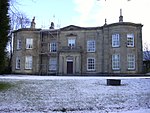Weir, Lancashire
Geography of the Borough of RossendaleUse British English from April 2015Villages in Lancashire

Weir is a village to the north of Bacup in the Rossendale borough of Lancashire, England, and immediately south of the boundary with the Borough of Burnley. The village had a population of 1,251 at the 2011 Census. Anciently, Weir constituted a hamlet, but later emerged as an outlying suburb of Bacup town after the Burnley Road turnpike was built through the settlement at the end of the 18th Century.
Excerpt from the Wikipedia article Weir, Lancashire (License: CC BY-SA 3.0, Authors, Images).Weir, Lancashire
Weir Lane, Borough of Rossendale
Geographical coordinates (GPS) Address Nearby Places Show on map
Geographical coordinates (GPS)
| Latitude | Longitude |
|---|---|
| N 53.723 ° | E -2.197 ° |
Address
Weir Lane
Weir Lane
OL13 8QA Borough of Rossendale
England, United Kingdom
Open on Google Maps








